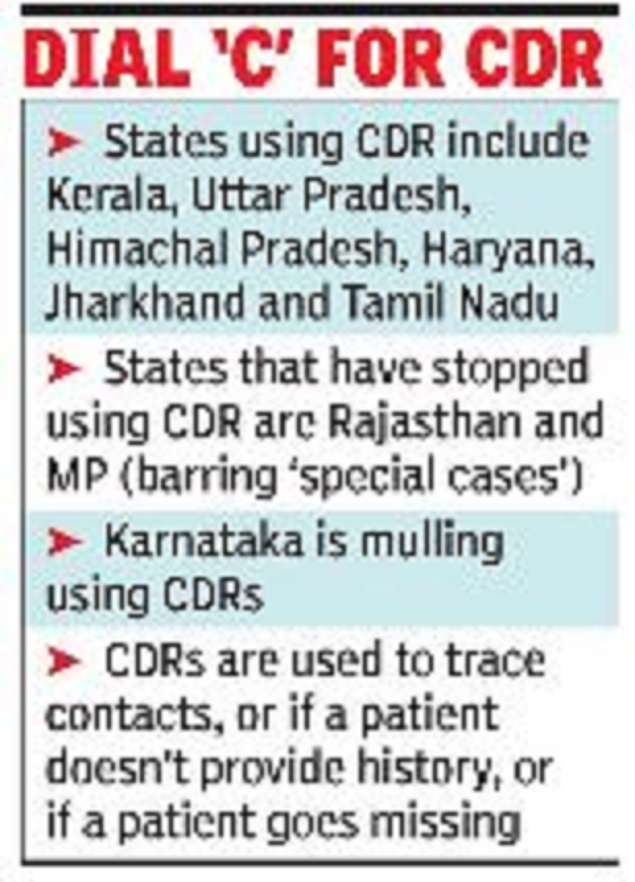NEW DELHI: Kerala and Uttar Pradesh are not the only states tracing contacts of Covid positive patients with the help of their call detail records (CDRs). At least six other states are using or have taken this route earlier to contain the spread, while some are mulling using this method.
In some states, this was done in the initial stages when the pandemic struck to trace contacts of those who attended the Tablighi Jamaat in Delhi. Other states are using it for various reasons — from tracing contacts of patients not willing to reveal contact history to those who went missing after testing positive.
In Himachal Pradesh, the police have been using CDRs to trace contacts of those patients “who do not cooperate and do not provide contact history”. “This is, however, not a regular practice. It was used mostly in the initial days to trace the contacts of Tablighi Jamaat members,” said a state government official.
When Covid cases spiked in Rajasthan in the initial period, the police used CDRs of infected people. This practice stopped when unlocking began on June 1.
Madhya Pradesh used CDRs to trace contacts till July 30. Now, CDRs are used only in “special cases, where contact tracing is proving impossible or if it is imperative to find out how the person got infected”. “Sometimes, a patient is not in a condition to speak and reveal who all he had met. However, there is no call interception involved,” said a senior police officer.
The Haryana government, too, is using CDRs of Covid-19 patients for contact tracing. In Jharkhand, police are using CDRs in case a Covid1-19 patient is untraceable. “When a positive patient goes missing, CDRs are used to trace locations from where calls are being made or received, and thus track the person,” said Ranchi sub-divisional magistrate Lokesh Mishra.
“In the first three months, we often sought police help. Now, more than 98% of contacts of positive patients are traced by health workers. The police use many methods including use of CDRs,” a senior official in the public health department in Tamil Nadu said.
While state agencies in Gujarat have not issued official orders to use CDRs for contact tracing, sources in the government said CDRs were used initially Read More – Source
NEW DELHI: Kerala and Uttar Pradesh are not the only states tracing contacts of Covid positive patients with the help of their call detail records (CDRs). At least six other states are using or have taken this route earlier to contain the spread, while some are mulling using this method.
In some states, this was done in the initial stages when the pandemic struck to trace contacts of those who attended the Tablighi Jamaat in Delhi. Other states are using it for various reasons — from tracing contacts of patients not willing to reveal contact history to those who went missing after testing positive.
In Himachal Pradesh, the police have been using CDRs to trace contacts of those patients “who do not cooperate and do not provide contact history”. “This is, however, not a regular practice. It was used mostly in the initial days to trace the contacts of Tablighi Jamaat members,” said a state government official.
When Covid cases spiked in Rajasthan in the initial period, the police used CDRs of infected people. This practice stopped when unlocking began on June 1.
Madhya Pradesh used CDRs to trace contacts till July 30. Now, CDRs are used only in “special cases, where contact tracing is proving impossible or if it is imperative to find out how the person got infected”. “Sometimes, a patient is not in a condition to speak and reveal who all he had met. However, there is no call interception involved,” said a senior police officer.
The Haryana government, too, is using CDRs of Covid-19 patients for contact tracing. In Jharkhand, police are using CDRs in case a Covid1-19 patient is untraceable. “When a positive patient goes missing, CDRs are used to trace locations from where calls are being made or received, and thus track the person,” said Ranchi sub-divisional magistrate Lokesh Mishra.
“In the first three months, we often sought police help. Now, more than 98% of contacts of positive patients are traced by health workers. The police use many methods including use of CDRs,” a senior official in the public health department in Tamil Nadu said.
While state agencies in Gujarat have not issued official orders to use CDRs for contact tracing, sources in the government said CDRs were used initially Read More – Source










